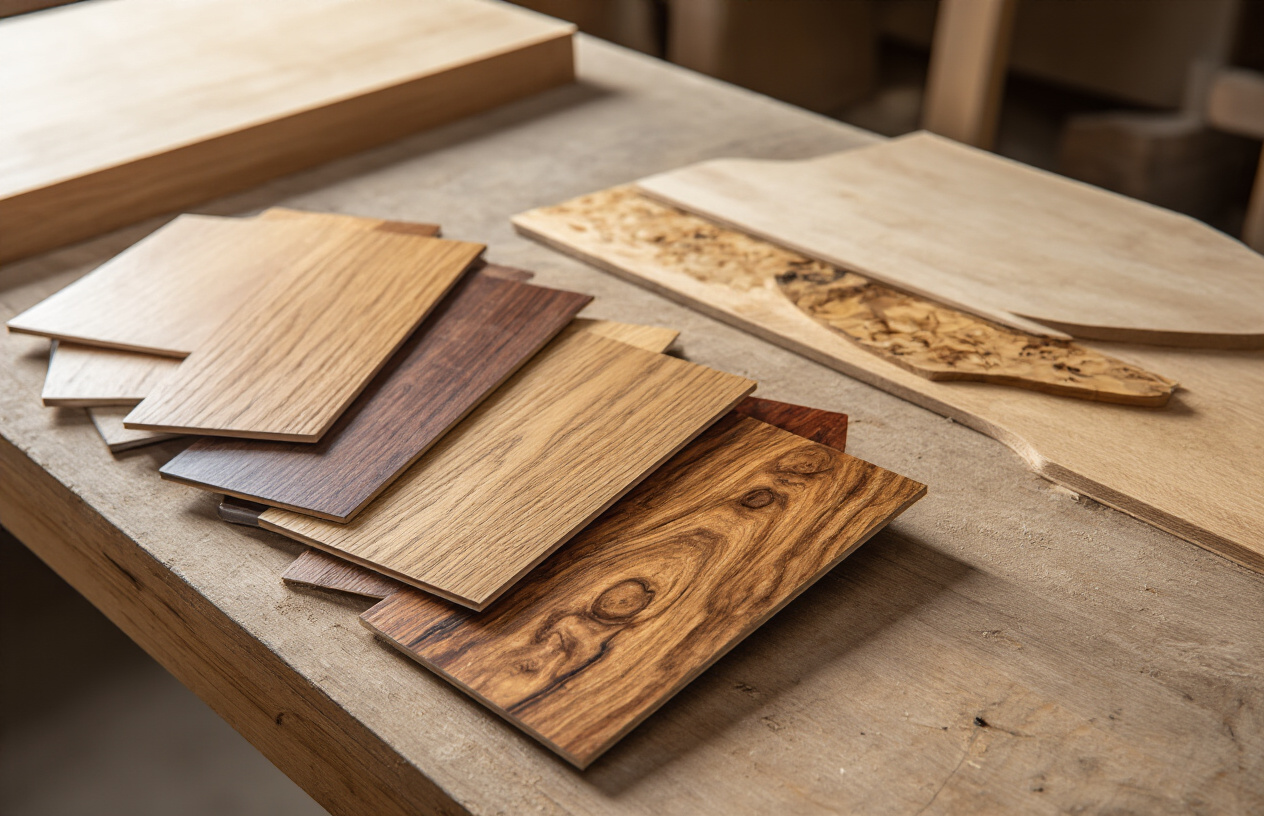Wood veneer transforms ordinary furniture and cabinetry into stunning showpieces. This guide helps DIYers and professional woodworkers understand the different wood veneer options available for their next project. We’ll explore natural wood veneer categories, man-made alternatives, and the cutting techniques that create distinctive grain patterns in each sheet.
Understanding Wood Veneer Basics
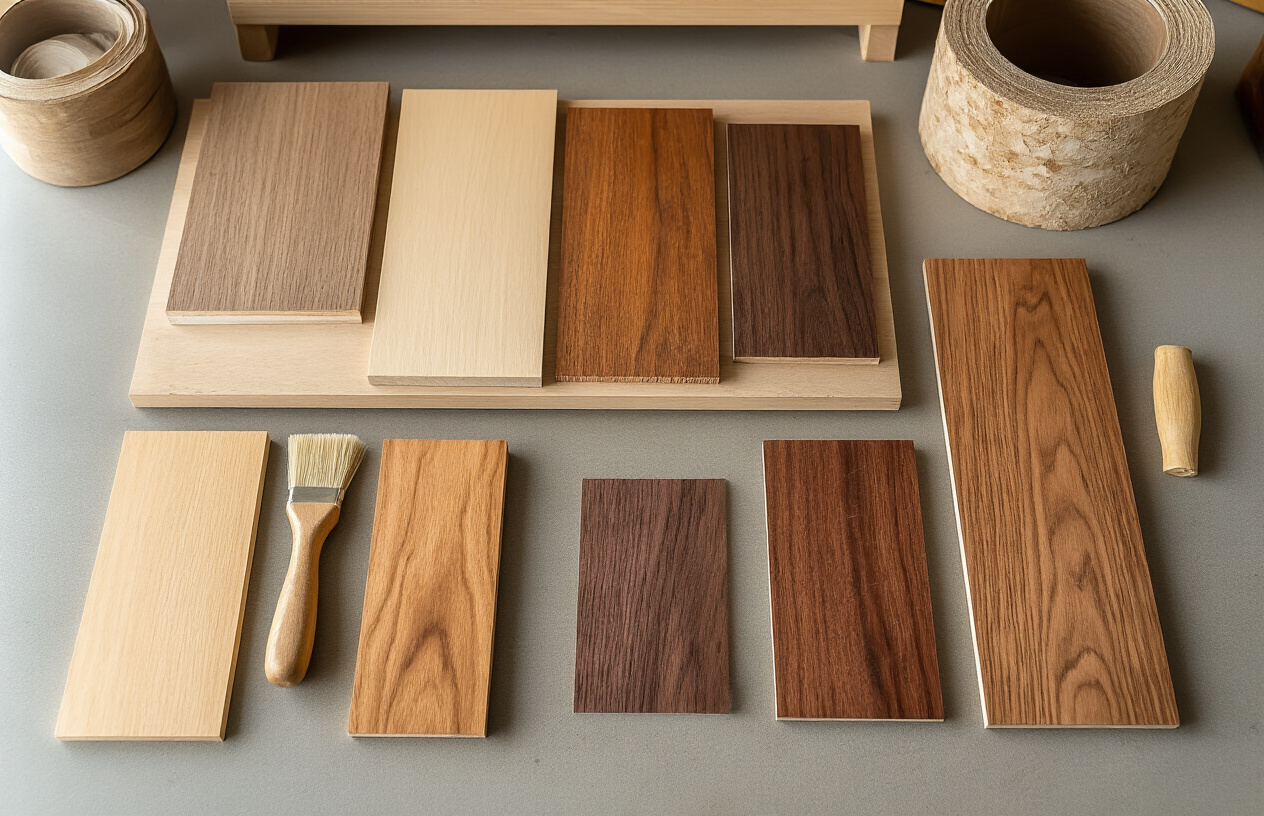
What Makes Wood Veneer Different from Solid Wood
Wood veneer isn’t just a cheap alternative to solid wood—it’s a completely different approach to woodworking with its own set of advantages.
The biggest difference? Thickness. Veneer is super thin—typically between 1/42″ to 1/16″ thick. Solid wood, on the other hand, comes in much thicker cuts and is used for the entire piece of furniture.
Think of veneer as the fancy outfit your furniture wears. It’s a thin slice of premium wood that covers less expensive material underneath. This lets you get that gorgeous grain pattern of rare woods without cutting down entire forests or emptying your wallet.
But don’t mistake veneer for fake wood. It’s 100% real wood, just used more efficiently.
How Veneer is Manufactured
The process of creating veneer is pretty fascinating. It starts with carefully selecting logs, then softening them with steam or hot water. Once prepped, they’re sliced using one of four main methods:
- Rotary cutting – The log spins against a blade like unrolling a paper towel, creating wide sheets with dramatic grain patterns
- Plain slicing – Cuts parallel to the center of the log, producing those cathedral patterns you see in traditional furniture
- Quarter sawing – Cutting perpendicular to the growth rings for straight, consistent grain patterns
- Rift cutting – Similar to quarter sawing but at a slightly different angle to minimize flake patterns in oak
Environmental Benefits of Using Veneer
Wood veneer is the environmentalist’s friend in the furniture world.
A single log converted to veneer can cover 30+ times more surface area than the same log cut into solid lumber. That’s a game-changer for conservation.
Rare and exotic wood species can be used sustainably since veneer uses so little material. One tree can produce enough veneer for dozens of furniture pieces instead of just a few solid wood items.
The core materials often used beneath veneer—like MDF or particleboard—frequently come from recycled wood products or fast-growing species, reducing waste and promoting responsible forestry.
Plus, veneer furniture typically lasts for decades, extending the environmental benefits of your purchase.
Natural Wood Veneer Categories
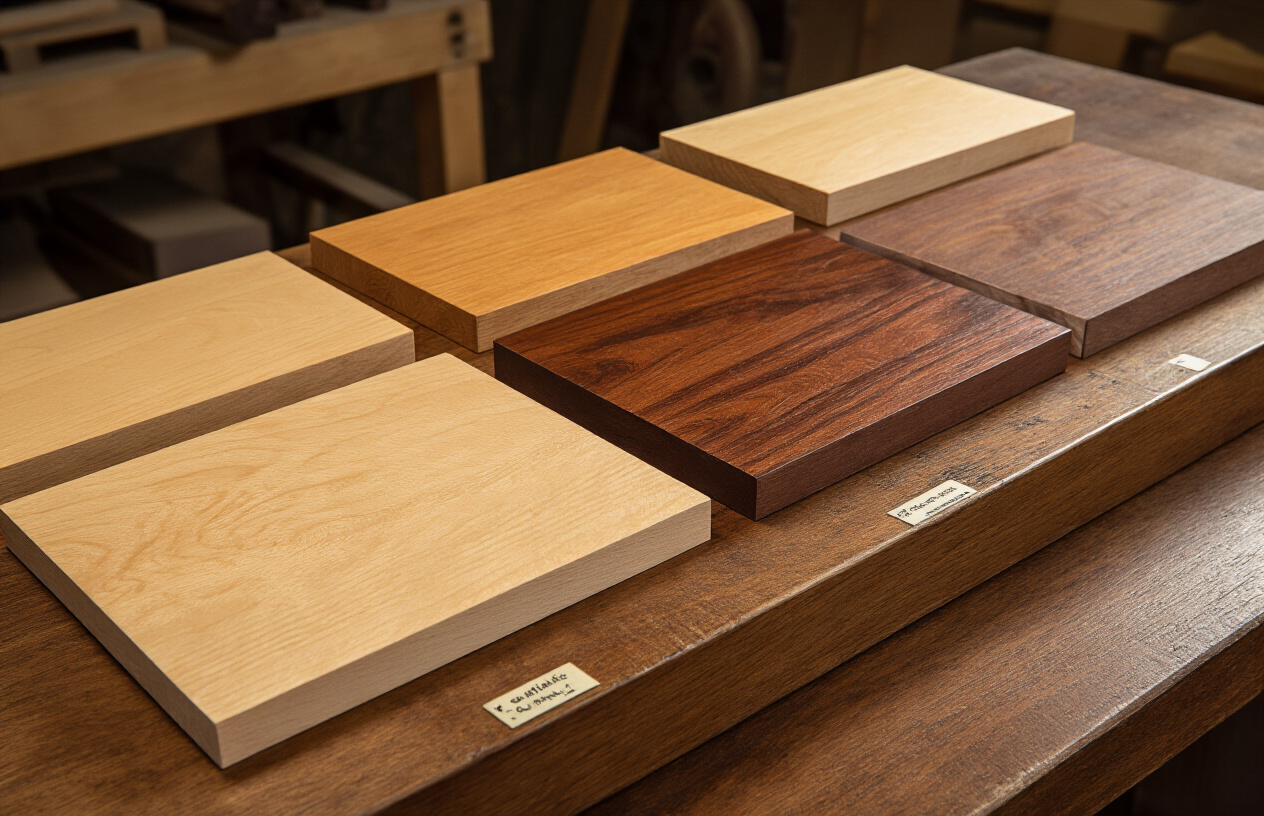
Hardwood Veneers (Oak, Maple, Walnut)
Hardwood veneers are the workhorses of the veneer world. Oak gives you that classic, timeless look with its prominent grain patterns. Red oak? Bold and assertive. White oak? More subtle but with an elegant, linear grain.
Maple is the chameleon of hardwoods. It’s pale, uniform, and takes stain like a dream. Bird’s eye maple features those distinctive small, circular patterns that look like tiny eyes scattered across the surface. Absolutely stunning in contemporary designs.
Walnut steals the show with its rich, chocolate-brown tones. The grain varies from straight to wavy, and it darkens beautifully with age. No wonder it’s the go-to for high-end furniture and architectural panels.
Exotic Veneers and Their Unique Characteristics
Exotic veneers bring drama to any project. Zebrawood isn’t subtle with its bold, contrasting stripes. Bubinga offers deep reddish tones with purple highlights and interlocking grain patterns.
Macassar ebony? Now we’re talking luxury. Those dramatic black stripes against a caramel background make it impossible to ignore.
Rosewood varieties deliver spectacular color variations from deep browns to purples with black streaking. Just be aware of CITES regulations since some species are protected.
Softwood Veneer Options
Don’t overlook softwoods! Pine veneer gives you that warm, knotty character perfect for rustic designs. Cedar brings a distinct aroma along with its reddish tones – great for lining closets and chests.
Douglas fir shows straight, pronounced grain patterns with a yellowish-tan color that matures to a rich honey tone. It’s surprisingly durable for a softwood veneer.
Burls, Crotches, and Specialty Cuts
Burl veneers showcase nature’s wildest side. These gnarly growths from tree trunks produce swirling, dramatic patterns that look almost alien. Walnut and maple burls command premium prices for good reason.
Crotch veneers come from where major branches meet the trunk, creating feathered or flame-like patterns. Mahogany crotch veneer might be the most prized of all with its 3D, cathedral-like appearance.
Bird’s wing cuts reveal asymmetrical beauty with flowing, rhythmic patterns. Pommele veneer shows a distinctive quilt-like surface with small, round bumps creating a bubbly appearance.
Man-Made Veneer Varieties
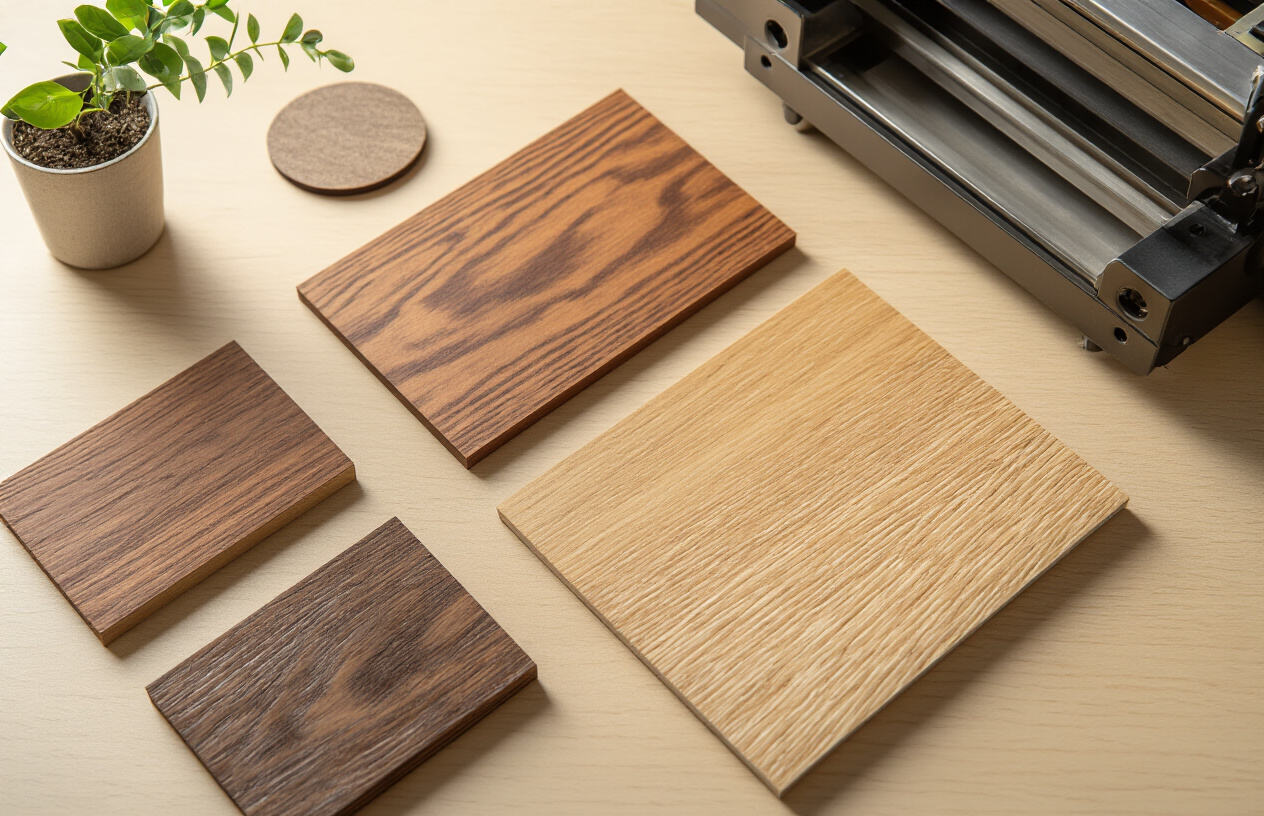
Reconstituted Veneers and Sustainability
Want to go green with your next project? Reconstituted veneers might be your answer. These innovative materials take wood scraps and leftovers—stuff that would otherwise end up in landfills—and transform them into something beautiful and useful.
Think of it like recycling, but for luxury surfaces. Manufacturers take wood waste, dye it to the desired color, and then glue it together to create consistent sheets with predictable patterns. The result? Less waste and more efficient use of our forest resources.
The sustainability angle isn’t just marketing talk. One sheet of reconstituted veneer can cover 3-4 times more surface area than natural veneer from the same amount of timber. That’s a big win for our forests.
Paper-Backed vs. Wood-Backed Options
Choosing between paper and wood backing comes down to your specific needs.
Paper-backed veneers are the flexible friend in your workshop. They bend easily around curved surfaces without cracking—perfect for those statement cylindrical columns or curved reception desks. They’re thinner too, which makes them easier to work with when you’re covering existing surfaces.
Wood-backed options bring extra stability to the table. They’re sturdier, less prone to warping, and can handle more punishment during installation. The trade-off? They’re less flexible and typically more expensive.
| Backing Type | Flexibility | Stability | Best For |
|---|---|---|---|
| Paper | High | Lower | Curved surfaces, overlay work |
| Wood | Low | Higher | Flat surfaces, demanding applications |
Engineered Veneers for Consistency
Ever been frustrated by the unpredictability of natural wood? Engineered veneers solve that problem.
These man-made alternatives deliver consistent color, grain patterns, and texture every single time. No surprises when you order additional sheets for a project expansion—what you got last time is what you’ll get this time.
Designers love them because they can create looks that don’t even exist in nature. Want a perfect mahogany shade that’s exactly the same across your entire hotel lobby? Engineered veneer has you covered.
They’re typically more resistant to fading too, which means less maintenance and longer-lasting beauty. And the technology keeps improving—some of today’s premium engineered veneers are so convincing that even wood experts have to look twice.
Veneer Cutting Techniques
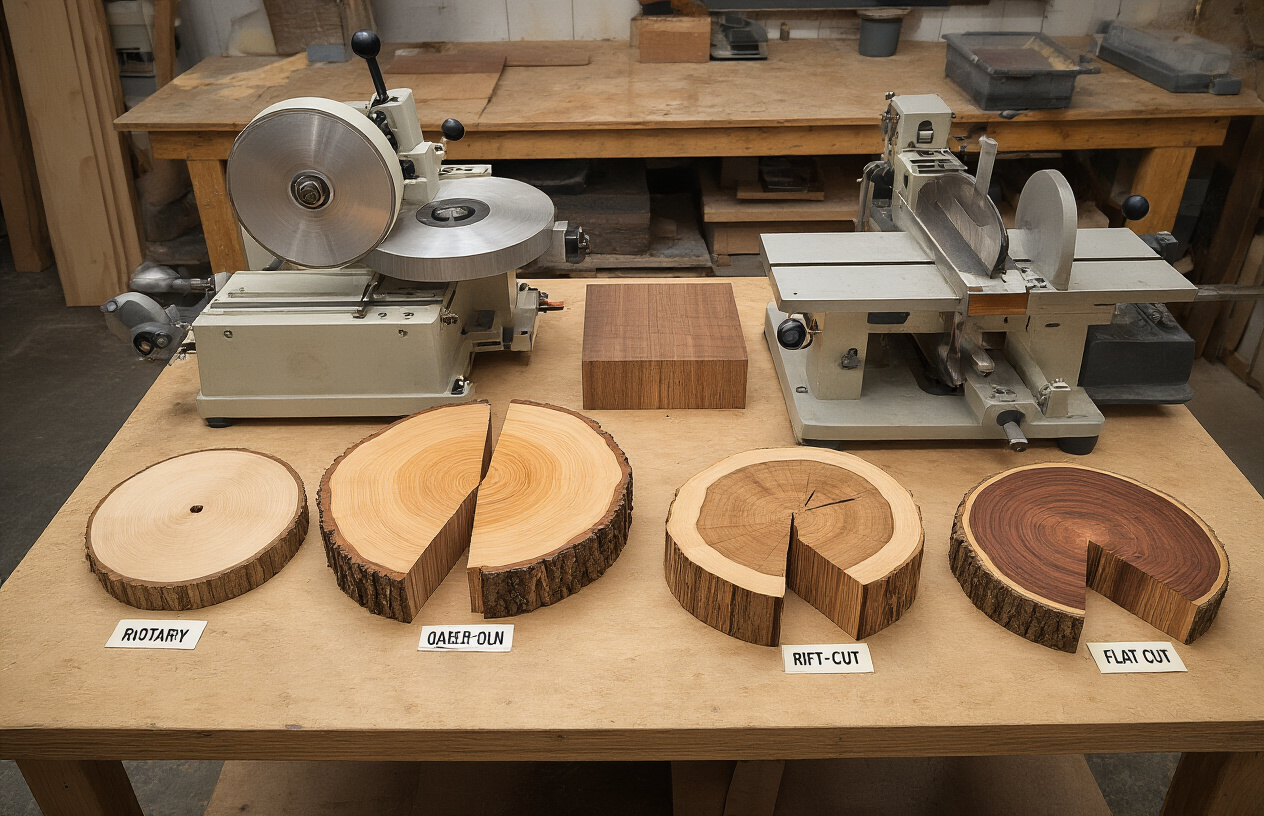
Plain Sliced/Flat Cut for Traditional Patterns
Ever seen those classic wood patterns that just scream “timeless elegance”? That’s flat cut veneer for you. The log is sliced parallel to the center of the tree, creating those beautiful cathedral patterns that flow like waves across furniture surfaces.
This is by far the most common cutting technique – and for good reason. It gives you the most yield from each log while showcasing the wood’s natural character. Mahogany, oak, and walnut really shine when plain sliced, bringing out those sweeping grain patterns that furniture makers have loved for centuries.
The best part? It’s typically more affordable than other cuts while still looking absolutely stunning.
Quarter Sawn for Straight Grain Appearance
Quarter sawn veneer is the perfectionist’s dream. The log is cut at a radial angle to the growth rings, resulting in straight, consistent grain patterns with minimal movement.
What makes quarter sawn special? Those distinctive flecks and ribbons (especially in oak) that catch the light just right. Furniture makers love it because it’s incredibly stable and resistant to warping. That’s why you’ll spot it in high-end musical instruments, cabinetry, and architectural details.
It’s pricier than plain sliced, but worth every penny when you need that straight-grain look that stays put for decades.
Rift Cut for Minimal Flake
Think of rift cut as quarter sawn’s more consistent cousin. It’s cut at a slightly different angle specifically designed to minimize those medullary ray flecks while maintaining the straight grain appearance.
Oak veneer particularly benefits from rift cutting when you want that clean, contemporary look without the traditional flecking. This technique produces some of the most uniform grain patterns possible.
Designers love rift cut for modern applications where consistency matters more than dramatic character. The grain typically runs vertically with tight, parallel lines that create a sophisticated, understated elegance.
Rotary Cut for Dramatic Patterns
Want maximum drama? Rotary cut veneer delivers big time. The log spins against a blade like a giant pencil sharpener, peeling off one continuous sheet. This technique captures the widest possible grain pattern, creating bold, sweeping visuals that make a statement.
Birch and maple are particularly stunning when rotary cut. You’ll recognize this style in plywood backing and decorative panels where wide, dramatic grain patterns are desirable.
The wild grain makes it trickier to match, but when you want that eye-catching wood movement that fills a space with energy, nothing beats rotary cut veneer.
Specialty Cuts for Unique Effects
Beyond the standard techniques lies a world of specialty cuts that create truly unique veneer effects:
Bias cutting introduces fascinating diagonal grain patterns by slicing the log at an angle to its length. Half-round cutting (something between plain slicing and rotary cutting) creates distinctive grain patterns with more consistency than rotary but more drama than flat cut.
Then there’s figured wood veneer – burl, bird’s eye, quilted, and pommele patterns that showcase nature’s most spectacular wood anomalies. These specialty cuts transform ordinary wood species into extraordinary design elements that become the focal point of any space.
Exotic specialty cuts come at a premium price, but they’re the secret weapon of designers looking to create truly one-of-a-kind pieces.
Selecting the Right Veneer for Your Project
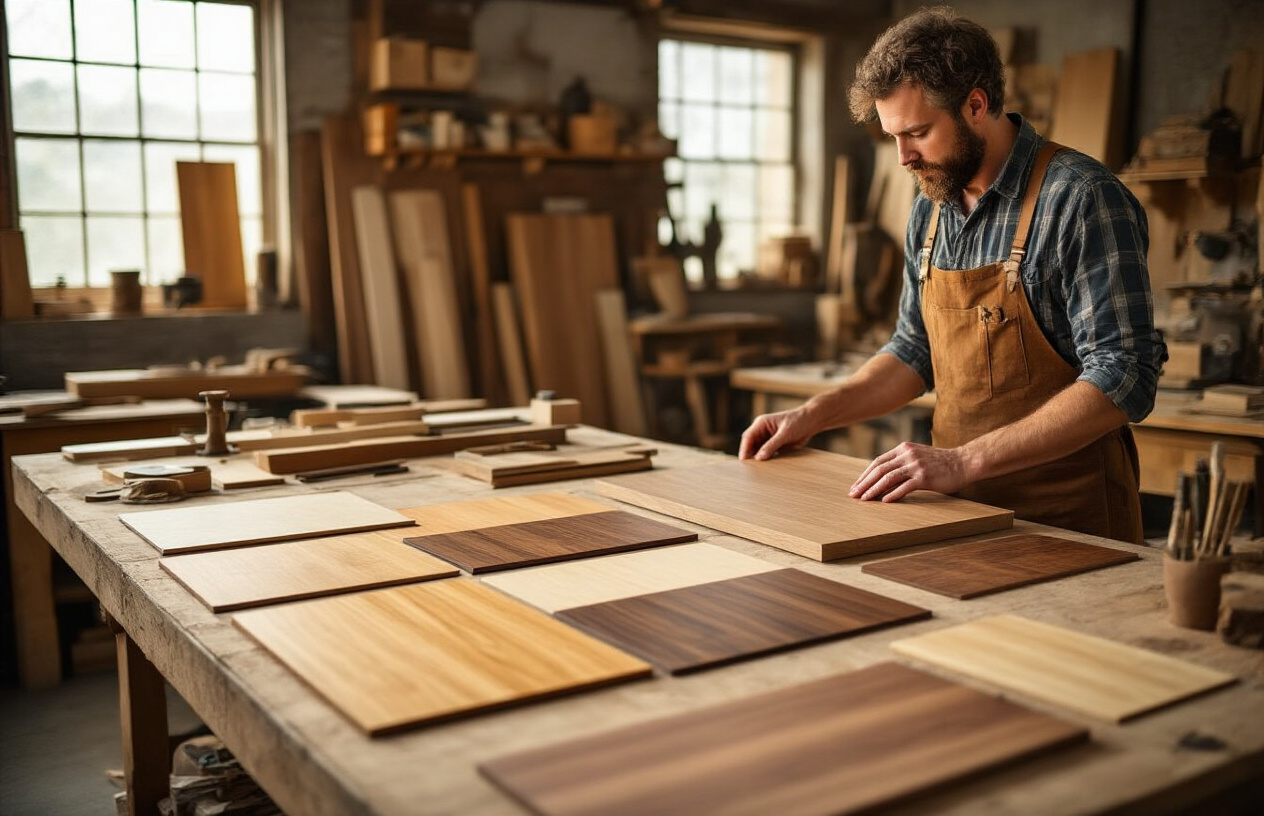
Matching Types and Visual Effects
Picking the right veneer isn’t just about grabbing whatever looks pretty. It’s about finding that perfect match for your vision.
Want drama? Burled veneers with their swirling, dreamlike patterns make statement pieces that’ll have guests asking, “Where’d you get that?”
Need something classic? Oak and maple veneers bring timeless appeal with their straight, predictable grain patterns. They’re like the reliable friends of the veneer world.
Quarter-sawn veneers show off those gorgeous flecks and ribbons that scream “quality craftsmanship.” They’re perfect when you want to flex your woodworking muscles without saying a word.
For modern vibes, anigre and figured sycamore deliver contemporary looks with their subtle, sophisticated grain. They’re understated but still turn heads.
Durability Considerations for Different Applications
Some veneers just can’t handle the heat—or the humidity, or the sunlight.
Maple and cherry veneers might look gorgeous, but they’ll throw a fit in direct sunlight, darkening faster than you can say “expensive mistake.” Keep these babies away from windows.
Teak and walnut? Now we’re talking tough. These hardwood veneers laugh in the face of wear and tear, making them perfect for high-traffic furniture like dining tables and desks.
For kitchen cabinets, stick with oak or ash veneers. They handle humidity changes like champs and won’t warp when you’re boiling pasta for the fifth time this week.
Bathroom vanities? You need water-resistant options. Engineered veneers with their added stability beat natural veneers here every time.
Cost Comparison Across Veneer Types
Wood veneer prices can make your wallet cry or smile, depending on what you choose.
| Veneer Type | Price Range | Best For |
|---|---|---|
| Common Oak/Maple | $2-5/sq ft | Budget projects, learners |
| Walnut/Cherry | $6-12/sq ft | Mid-range furniture, accent pieces |
| Exotic (Zebrawood/Bubinga) | $15-30/sq ft | Statement pieces, luxury items |
| Burled/Figured | $20-50+/sq ft | High-end furniture, showstoppers |
| Engineered | $3-10/sq ft | Commercial projects, consistency |
The raw material is just the start. Factor in backing, glue, and finish—they’ll add 30-50% to your material costs.
Best Veneers for Furniture vs. Cabinetry
Furniture demands different veneers than cabinetry. It’s not a one-size-fits-all game.
For dining tables, walnut veneer brings richness that improves with age. It handles hot plates better than you’d expect and develops character with use.
Bedroom furniture? Cherry veneer’s warm reddish tones create cozy, inviting spaces. Plus, it’s stable enough for those big drawer fronts.
Kitchen cabinets need workhorses. Maple veneer takes stains like a dream and handles cleaning products without throwing a fit. Oak works too, but those deep grain patterns collect grime in busy kitchens.
For office cabinetry, mahogany veneer offers professional vibes while handling paperwork traffic. It’s the power suit of veneers.
Remember: book-matched veneers (where grain patterns mirror each other) elevate furniture but waste material. For budget cabinetry projects, slip-matched veneers stretch your dollar further.
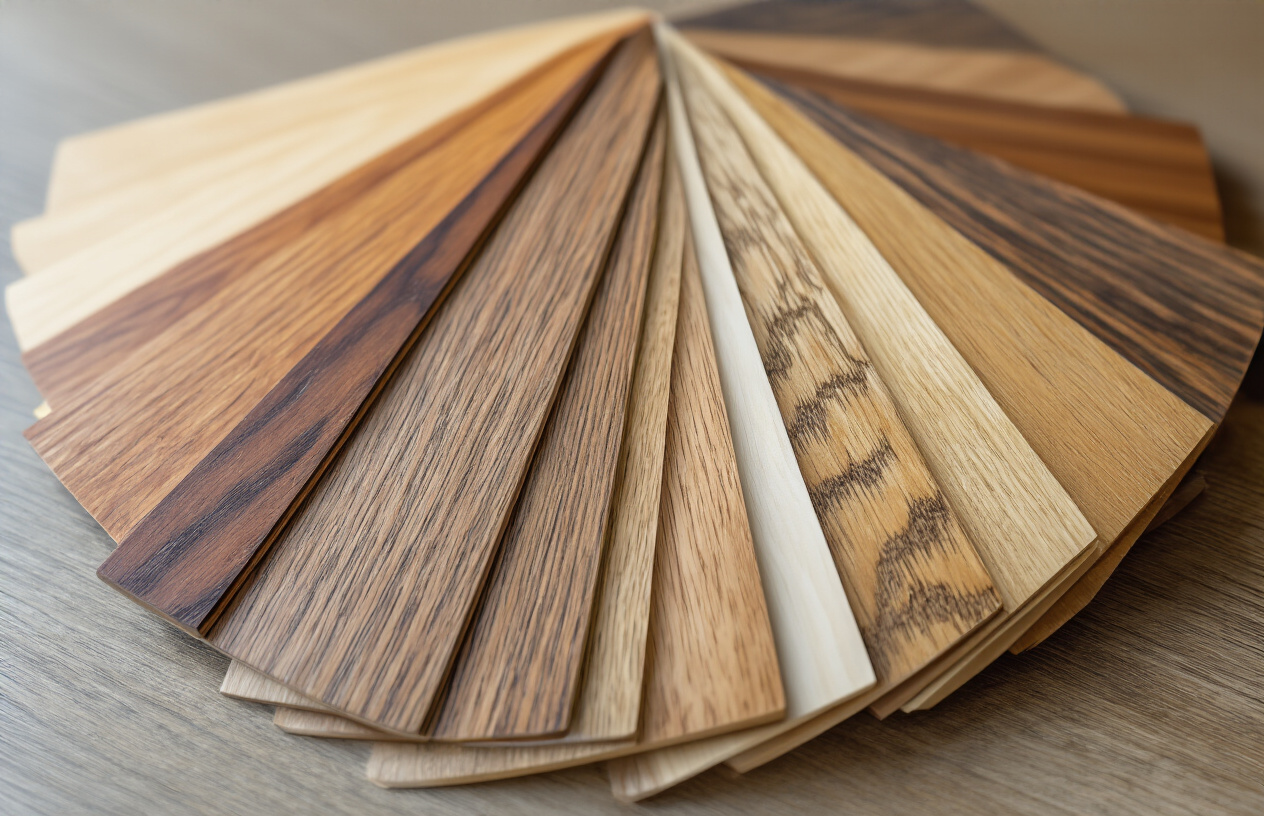
Choosing the right wood veneer involves understanding the different types available and how they’ll perform in your specific application. Whether you opt for the luxurious look of natural veneers like oak, maple, or exotic species, or prefer the consistency and durability of engineered options like reconstituted or paper-backed veneers, each offers distinct advantages. The cutting method—whether rotary, plain-sliced, quarter-sliced, or rift-cut—dramatically affects the final aesthetic and should be selected based on your design vision.
As you embark on your next woodworking or renovation project, take time to consider not just the appearance of your veneer choice, but also its application environment, sustainability factors, and maintenance requirements. The perfect veneer balances beauty with practicality, enhancing your project while meeting your specific needs and values. Visit your local supplier to see and feel samples in person—there’s no substitute for experiencing these remarkable materials firsthand before making your final decision.
https://smartbuzzhub.com/the-latest-trends-in-natural-veneer-furniture-and-panels/
